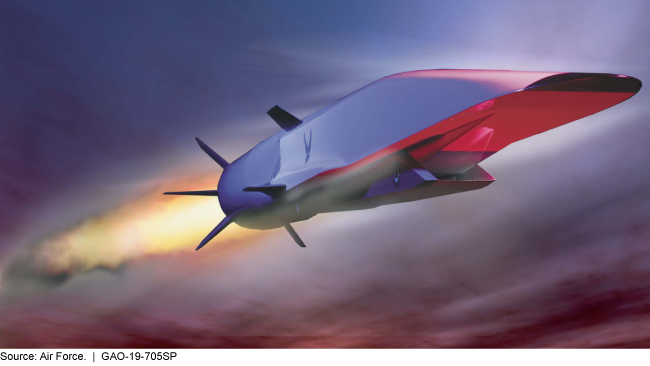Attention: US GAO Informs Public About Hypersonic Weapons
The U.S. Government Accountability Office (GAO) published a new report about hypersonic weapons, including hypersonic glide vehicles (HGVs) and hypersonic cruise missiles (HCMs), and their development as the race for hypersonic technology heats up with Russia and China.
Hypersonic weapons fly between Mach 5 (3,836 mph) and Mach 10 (7,672 mph) and have the ability to out outmaneuver the world’s most advanced missile defense systems, such as the US MIM-104 Patriot and Russian S-400 missile system.
As shown in the GAO diagram, the HGVs and HCMs fly at lower altitudes and unpredictable flight paths than a traditional ballistic missile that flies typically at an arch from launch to target.
Hypersonic weapons have extreme maneuverability capabilities which make it difficult to defend against.
GAO said HGVs are hypersonic gliders that are initially propelled with a rocket to altitudes between 25 and 60 miles.
High-speed engines power HCMs during the entire flight. Can fly at altitudes between 12 and 19 miles.
“For most HCMs, a rocket would accelerate the missile to Mach 3 or 4, and then the HCM’s own ramjet or supersonic combustion ramjet (scramjet) engine would take over. A ramjet uses the speed of the vehicle to “ram” and compress air with fuel, which is burned to produce thrust. A scramjet is similar, with air moving at supersonic speed,” the report said.
The GAO cited a recent update from the U.S. Air Force Scientific Advisory Board that said: “the core technologies needed for the development of a tactical range HGV have reached Technology Readiness Level (TRL) 5 out of 9. The board expected the remaining subsystems for such a weapon to reach TRL 6 or higher by 2020. According to GAO best practices, TRL 7 is the level of technology maturity that constitutes a low risk for starting system development. It indicates that technology has achieved form, fit, and function, and has been demonstrated in an operational environment.”
GAO lists several important features of hypersonic weapons, and how these weapons will make warfighting against major adversaries easier.
- Penetrate defenses: Hypersonic weapons would likely enable U.S. warfighters to penetrate existing adversary anti-aircraft and anti-missile systems because of their speed, maneuverability, and altitude (above typical anti-aircraft defenses and below interception points for ballistic reentry vehicles).
- Strike fleeting targets: The speed of hypersonic weapons would allow them to hit targets that are only vulnerable for a limited time, such as mobile, high-value military targets and adversary weapons systems.
- Agile targeting: A traditional missile needs to be launched with a target in mind, but a hypersonic weapon could be maneuvered later in flight. This could provide U.S. decision-makers more time and make it extremely difficult for adversaries to prepare.
- High travel speeds: Piloted hypersonic vehicles would allow for very short travel times and may have commercial applications. Such vehicles have essentially been limited to certain spacecraft reentering the atmosphere and experimental aircraft.
GAO also lists the challenges of developing a hypersonic weapon, and are likely some of the reasons why the U.S. is losing the weapons race against Russia and China.
- Heat-tolerant materials: At hypersonic speeds, the exterior temperature of a hypersonic vehicle or weapon can exceed 2,000°F, necessitating advanced materials that will protect interior electronics. Such materials also need to be mechanically strong and efficient.
- Propulsion technology: Refinement of engine technology is needed for HCMs. This includes increasing the reliability and efficiency of scramjet engines. New types of engines that allow for propulsion from standstill to hypersonic speeds are also being developed, which would eliminate the need for rockets to provide the initial launch.
- Weapon tracking: Defense against a hypersonic weapon would involve tracking and intercepting it, but current radar and satellite systems are inadequate for this task.
- Limited testing resources: There are limited places to perform ground tests and flight tests of hypersonic weapons and vehicles in the United States. Currently, there are limited wind tunnel facilities in the country capable of running propulsion tests of hypersonic weapons and vehicles.
- Safety and control: Hypersonic velocities require additional improvements of aircraft control and guidance to help ensure the accuracy of hypersonic weapons and to
Within the Department of Defense (DOD), several top-secret programs by the Defense Advanced Research Projects Agency (DARPA), the Air Force, the Navy, and the Army have received billions of dollars in the last several years to develop hypersonic weapons.
GAO warns that these technologies aren’t mature and it could take time until deployment.
Meanwhile, Russia and China have been testing and deploying such weapons, signaling that the U.S. is rapidly losing its global air supremacy, and another reason why the world is marching closer to war.
Tyler Durden
Thu, 09/19/2019 – 01:00![]()
Zero Hedge’s mission is to widen the scope of financial, economic and political information available to the professional investing public, to skeptically examine and, where necessary, attack the flaccid institution that financial journalism has become, to liberate oppressed knowledge, to provide analysis uninhibited by political constraint and to facilitate information’s unending quest for freedom. Visit https://www.zerohedge.com




